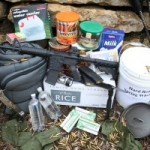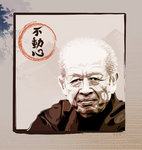A Modern E and E kit
The ancient Ninja were always prepared to escape and evade as if they were caught on a mission it would most likely end in torture and or death. Depending on the type of mission they would carry typical ningu(tools) to help them accomplish their mission as well as to escape the scene if and when necessary. Items such as kaginawa, kunai, metsubishi, tetsubishi, shuriken, fire making tools, cloth and first aid supplies were all utilized and carried by our ancient practitioners. Now recently I read an article on a Solicitation by SOCOM for a new personal Escape and Evasion kit for the Navy SEAL teams, and thought it very applicable to our own training and preparedness for an emergency, so I am presenting that material here for you to add to your training.
SEAL E & E Kit
The soft case, measuring 3.5 by 2.25 inches, will feature a U.S. flag patch (so much for keeping your nationality secret, although one has to believe it’s removable), be “subdued desert in color” and feature a “hook fastener (i.e. hard side of velcro) sewed to back with a slit in order to store and retrieve contents below yet hold contents down while worn.”
The SEAL’s hard-storage case will contain (quoting directly from the solicitation):
1. Mini-Multi Tool with:
a. Stainless Steel
b. Pliers
c. Wire cutter
d. File
e. Awl
f. Packaged so as to not rattle in case
2. Button Compass
a. Quality AA
b. 14mm
c. Liquid dampened
d. Minimum 8 hour luminous
3. LED Squeeze Light
a. Red
b. Continuous or Momentary Switch
4. Fire Starting Kit
a. Ferro cerium rod not to exceed 3”L x 8mm W
b. Tinder tabs (4) packaged in reclosing bag.
5. Water Storage Device
a. 2L capacity
b. Able to hold all contents of the kit
c. Must be sealable and reuseable
d. Must be odor proof
6. Water Purification Tablets
a. 40 tablets
b. Packaged in amber, medical grade borosilicate
7. Electrolyte Tablets
a. 2 tablets
8. Signal Mirror
a. 2”x 3”
b. Non-mirrored side covered with an IR reflective material
c. Mirror side must be protected to prevent scratches. Protective cover must be able to be removed with one hand.
d. Must have an aiming hole
9. Thermal Blanket
a. 21” x 56” x .05mil
b. Polyester, aluminized
c. 1 side silver, other side orange
d. Packaged in plastic with easy tear pre-cuts
10. Kevlar Line
a. Yellow or green in color
b. 188lb test
c. 15 feet in length
d. Packaged in plastic with easy tear pre-cuts
11. Safety Pins
a. Two #2 (1.5” steel)
b. Two #00 (.75” brass)
c. Packaged in plastic with easy tear pre-cuts.
12. P-38 can opener
a. Packaged so as to not rattle while in case.
13. Stainless Steel Wire
a. 2’ of 20ga
14. Duct Tape
a. Brown or Green in color
b. 26” x 2”
15. Fresnel Magnifying Lens
a. 4x power
b. 3.25” x 2”
16. Waterproof Note Paper
a. 4 sheets
b. Desert tan color
c. 3.5” x 2”
17. Ink Pen
a. Pressurized ink cartridge
b. Black in color
18. Broad Spectrum Antibiotic Ointment
a. 1/32oz foil pack
19. Cotton Pad
a. 100% Cotton
b. 2” x 2.5”
c. Packaged in plastic with easy tear pre-cuts.
The contents of the soft storage case will include:
1. Hacksaw Blade
a. Carbon Steel
b. 24tpi
c. 2.75” L
d. Hole in one end for a lanyard
e. Opposite hole end, sharpen down reverse tanto-style end.
2. Ceramic Razor Blade
a. 1 or 2 sides sharpened
b. Packaged so as to not accidentally cut anything or dull
3. Moleskin Adhesive Patch
a. Heavy duty
b. 1.75” x 2.5”
4. Kevlar Thread
a. Green or yellow
b. 100-200lb test
c. 24” in length
d. Packaged in plastic with easy tear pre-cuts.
5. Fishing Leader/Downrigger Cable
a. Multi-strand
b. Stainless steel
c. 50lb test
d. 24” in length
6. Suspended Navigation Magnet
a. Identifiable north painting feature
b. Magnet suspended from thread/string
c. Packaged in plastic with easy tear pre-cuts.
7. Ferro Cerium Rod
a. 1.75” L x .125”W
8. Cotton Ball
a. Impregnated with wax.
b. Packaged in a reclosing bag.
9. Bobby Pins
a. Spring steel
b. 2 small
c. 1 large
d. Black in color
The final two items are worth singling out, because they highlight the optimism bred into every SEAL (and trump the safety and bobby pins):
10. Handcuff Shim (Pick)
11. Universal Handcuff Key
a. Non-metallic resin material
How to pack survival kits for stranded special-operations forces has been a subject the U.S. military has dealt with for at least the past half-century, according to this Army contracting guidance from back then:
An individual engaged in unconventional warfare and counter-guerrilla operations is frequently exposed to possible capture. In counter-guerrilla operations, indigenous elements with which a US soldier is working may be dispersed, causing complete separation of the soldier from the unit. While in an operational area, he must be continuously prepared to initiate evasive action and conceivably to continue evading for an extended period of time. His possession and proper use of a suitable survival kit may be the critical factor in effecting a successful juncture with friendly personnel. Therefore, there is a requirement for an individual aid and survival kit for issue to personnel participating in special warfare operations.

In a future post I will go into a few more details about creating a Tier 1 kit for your own use.
Bufu Ikkan
 event, the word is out and some people are preparing. With the Nat Geo Show “Doomsday Preppers” , the movie 2012, as well as Bear Grylls, Cody Lundin hitting the media, I thought it might be interesting to note that the ancient(and modern to) Ninja Clans were Japan’s answer to our modern prepping communities.
event, the word is out and some people are preparing. With the Nat Geo Show “Doomsday Preppers” , the movie 2012, as well as Bear Grylls, Cody Lundin hitting the media, I thought it might be interesting to note that the ancient(and modern to) Ninja Clans were Japan’s answer to our modern prepping communities.

